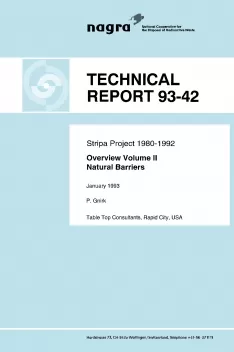
Technical Report NTB 93-42
Stripa Project 1980 – 1992Overview Volume IINatural Barriers
The International Stripa Project was a cooperative research and development project among several member countries of the Nuclear Energy Agency of the Organization for Economic Cooperation and Development. The project, which started in 1980 and ended in 1992, was conducted under the auspices of the Nuclear Energy Agency. The project was managed by the Swedish Nuclear Fuel and Waste Management Company (SKB) under the direction of a Joint Technical Committee (JTC) composed of representatives from participating countries.
The scientific and technical objectives of the project were to investigate several aspects of technology concerned with the feasibility and safety of disposal of long-lived, heat-generating radioactive waste at depth in granitic rocks. In particular, the Stripa Project addressed:
- the development of instruments and procedures to characterize candidate repository sites;
- the understanding and modelling of groundwater flow and solute transport in fractured crystalline rock; and
- the design of engineered barriers capable of contributing to waste isolation by restricting groundwater flow in proximity to the waste containers and in the surrounding host rock.
Because the activities and the results of the Stripa Project have been reported in more than 170 technical reports, the JTC has decided that the final action of the project should be the publication of an overview report that would convey, in relatively concise form, the body of information produced by the project.
The overview report has been subdivided into three volumes:
I. Executive Summary
II. Natural Barriers
III. Engineered Barriers
The Executive Summary summarizes the contents of the other two volumes with the addition of some general considerations about the Stripa Project. The authors of the Executive Summary are the five members of the Overview Reporting Group, that was established by the JTC for the purpose of producing the overview report. The Overview Reporting Group consisted of the two authors of volumes II and III, Paul Gnirk and Malcolm Gray, respectively, and two outside reviewers, Charles Fairhurst and Ferruccio Gera. The Project manager, Bengt Stillborg, acted as coordinator.
SCOPE OF THE REPORT
This report has been structured according to the three central themes of the Stripa Project that dealt with first the development and then the application of characterization methods and the modelling of groundwater flow and solute transport. Chapter 2 summarizes the development of the characterization methods; including the hydraulic, seismic, and radar borehole-testing methods, the hydrogeochemical characterization techniques, and the solute transport experiments. The application of these characterization methods is presented in Chapter 3 from the viewpoint of developing conceptual models of the geologic, hydrologic, and geochemical features of a rock mass. In particular, conceptualizations of the geohydrologic features of the Stripa area and the Crosshole site and SCV site within the Stripa mine are discussed in detail. Chapter 4 focusses on the modelling of groundwater flow and transport at the SCV site by means of equivalent-porous-media and fracture-flow models, including the development of such models and the evaluation of their validity for simulating groundwater flow and solute transport at the SCV site. Chapter 5 summarizes the significant achievements of the Stripa Project in terms of rock mass characterization, and discusses the potential for transfer of such technology to other sites and rock types.
